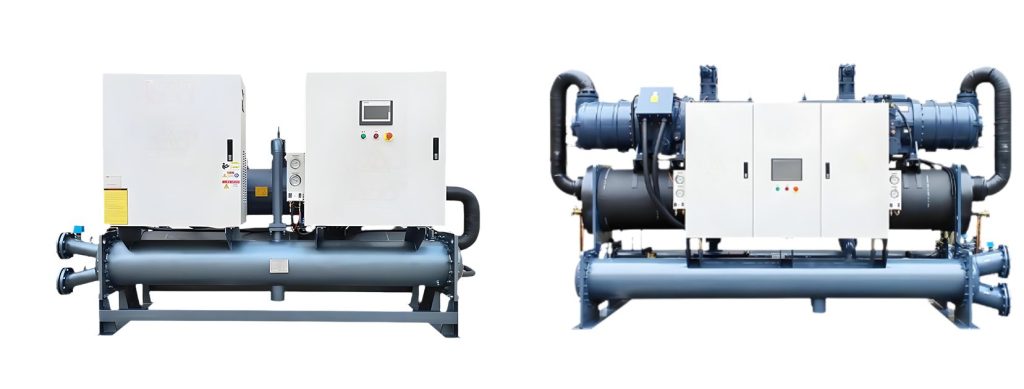What Affects the Discharge Pressure of the Chiller
The parameters of industrial chillers during operation can reflect the operating status. The high and low values can help you preliminarily determine the location and cause of the fault. This article introduces the impact of discharge pressure on the equipment.
What is Discharge Pressure?
After the refrigerant gas is compressed by the compressor, it will be discharged from the discharge port of the compressor and enter the condenser. The discharge pressure is the pressure measured when the refrigerant is discharged from the discharge port, which corresponds to the inlet pressure of the condenser.
A high discharge pressure means that the refrigerant temperature is higher and more heat must be released in the condenser to be condensed into liquid. During normal operation, the discharge pressure will always be within a specific range. If the discharge pressure changes, it means that there is a problem inside the cooling system.
Factors Affecting Discharge Pressure
The discharge pressure can be affected by many factors. Understanding the main influencing factors can help you accurately judge the operating status of the equipment during use and discover potential fault points as early as possible.
Heat dissipation capacity of the condenser
You may wonder, the discharge pressure measures the pressure at the discharge port of the compressor, why does the condenser in the next refrigeration link affect it? This is because the refrigeration cycle requires the participation of many components, and the discharge pressure is not only determined by the compressor, but also by the resistance of the discharge side circuit.
You can think of the compressor as the party that pushes the refrigerant gas, and the condenser as the party that receives the refrigerant gas. If the heat dissipation performance of the condenser is too poor and the refrigerant cannot be fully condensed, the condensation pressure will increase and be directly reflected at the compressor discharge port, causing the discharge pressure to rise synchronously.
Ambient temperature
In the process of cooling the refrigerant gas, the condenser needs to continuously release heat to the water or air. When the ambient temperature rises, the temperature of the cooling water and air will also rise. This will narrow the temperature difference between them and the refrigerant, making it difficult to discharge heat.
If the refrigerant cannot be reduced to a temperature that can fully condense, the pressure at the condenser outlet will be too high, causing the pressure in the entire refrigeration cycle to rise. In this way, the pressure at the compressor discharge port will continue to rise, forming a vicious cycle.
Type and level of refrigerant
At the same temperature, different refrigerants have different saturation pressures, and the saturation pressure affects the discharge pressure range when the cooling system is working normally. What is saturation pressure?
The temperature at which water boils at one atmosphere is 100°C, but in plateau areas, due to the low air pressure, water boils at 90°C. In a pressure cooker, it may take 110℃ to boil. This means that at a certain temperature, the pressure required for a liquid to become a gas is fixed, and this pressure is the saturation pressure.
The discharge pressure is essentially the saturation pressure corresponding to the temperature to which the gaseous refrigerant is compressed. Let’s take R22 and R134a as examples. At 35℃, the saturation pressure of R22 is about 1.4 MPa, while that of R134a is only about 0.85 MPa. This means that even under normal operation, the discharge pressure of a chiller using R22 is higher than that of a system using R134a.
In addition, the amount of refrigerant filled will also affect the discharge pressure. When the refrigerant is filled too much, the condenser may not be able to fully cool all the high-temperature gas, resulting in an increase in the discharge pressure.
Compressor load
The load of the compressor is its workload. The amount of refrigerant gas transmitted from the evaporator is the amount that the compressor has to compress. If there is too much gas, the burden on the compressor will increase. More gas is compressed to a high temperature and high pressure state, and the discharge pressure naturally becomes higher.

High Discharge Pressure
• Poor condenser heat transfer
• Inadequate cooling water (in water-cooled chillers)
• High ambient temperature
• Overcharging of refrigerant
• Non-condensable gases present in the system
Low Discharge Pressure
• Refrigerant undercharge
• Low system load
• Expansion valve malfunction (partially closed or blocked)
Fluctuating Discharge Pressure
• Unstable expansion valve control
• Inconsistent refrigerant level
• Compressor valve plate damage
• Faulty control system feedback
Tips
Suction pressure, condensing temperature, discharge temperature, superheat and other parameters should be analyzed together to accurately determine whether the cooling system has a fault.
Pay Attention to Discharge Pressure
The discharge pressure is equivalent to the barometer of the chiller and can reflect the health status of the equipment. Many chillers can display the discharge pressure in real time and are equipped with an abnormal pressure alarm function. If you still have questions about the discharge pressure or need to customize the chiller, LNEYA team is always available to support you.
Related chillers
CONTACT US
TEL:
EMAIL:
WeChat & WhatsApp:

Wechat QR

Have a question or need a quote? Fill out the form below, and our team will get back to you within 24 hours.
 LNEYA Industrial Chillers Manufacturer Supplier
LNEYA Industrial Chillers Manufacturer Supplier
















